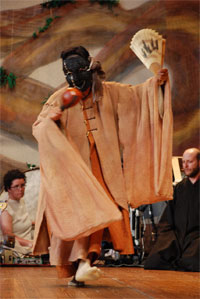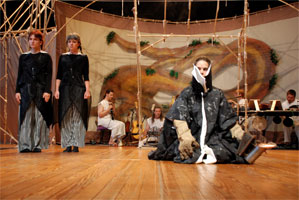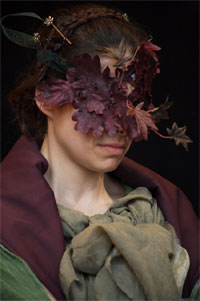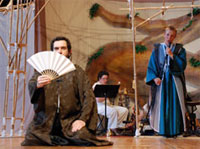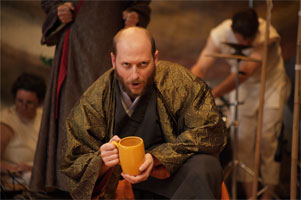The Yugen Process
Edited by Benito Bautista.
Audience Response Video
Edited by Benito Bautista.
The Cycle Plays
now available for touring
On 07/07/07 Theatre of Yugen presented The Cycle Plays, five plays performed during the course of a one-day-only presentation informed by the ritualistic Japanese Noh theater, written and directed in an ensemble process by Yugen’s Artistic Associate and playwright Erik Ehn. Musical composition by Allen Whitman and Suki O’Kane with the Yugen Orchestra.
This marathon theatrical event presents American stories told in the signature poetic, dance-drama style of Yugen, with its roots in the spirit of Noh, reaching up to new movement and narrative forms through pioneering contemporary music. The five categories of plays forming the traditional Noh architecture are re-invented in the lexicon of Western archetypes and with American legendary figures.
over the course of the three year devekpoment we created a wealth of materials; scripts, music mp3s, video, podcast interviews, photos, slideshows, artist statements, bios . . .
10,000
Opening Ritual - The "Okina"
The cycle begins with a ritual play called 10,000 created with Theatre of Yugen's founder Yuriko Doi. This adaptation is based on the traditional noh Okina, which one sees performed at noh theaters especially around the new year, and always at the opening of a full cycle.
The play is a series of dances and songs of blessing and gratitude with prayers for good fortune and longevity. Traditionally played by three men with an elder in the venerated role of Okina, our ritual is played by three women "Old women, Old women everywhere" featuring two of the company's founding members – Brenda Wong Aoki and octogenarian Helen Morgenrath.
Winterland
First Category - The God Play
Emma and Swan, two girls on the verge of adolescence, sneak out of their houses and into the woods. Their destination is Winterland, their goal, to see The Sex Pistols play.
An event is a crux in time. After this night, the band will no longer exist. After this month, Winterland will close. And this expedition, this transgression, is also a rite of passage for the girls, but into what?
On the way they see strange figures dancing in the snow: a leper, a beekeeper, and a milkman, all of whom are really the same man, Johnny Rotten, the iconoclast of whom they have made an icon. And they are distraught, disillusioned. They miss the concert.
What does it mean to have missed the concert, if they heard the music and saw the dance? Why do we seek identity in crowds and stand in line to see anarchy performed?
Emma and Swan never reach the shrine, but each person they meet on their pilgrimage is an avatar of the god.
synopsis by Edith Reisner Newton
Letters from a Small House
Second Category - The Warrior Play
A warrior kills because he is convinced that his cause is more important than his enemy’s life, and Ted’s cause--disclosed in his published manifesto--is a revolt against industrialization and the servitude that technology induces. If each letter is a bomb that targets a symbolic individual, each bomb is also a letter, an act of communication.
The technology of mass communication is paradoxically vital to Ted’s war against technology. Murder is required for the reinstatement of innocence. The mathematician exalts “wild nature, independent of human management.”
But Ted, besides being a self-styled freedom fighter using bombs to “send a message” to the enemy, is also David’s brother-- not only a myth but a man whom some people remember, and someone even loves.
It was David who revealed his brother’s identity to the police, and it is David who gives an interview to the press in this play. Does a brother who tells his brother’s story thereby become a stranger? Does a stranger who tells a stranger’s story thereby become his brother?
Letters from a Small House places in equal relief Ted’s rationales and his recollections, the atrocities he perpetrated and those he deplored, the narratives he constructed, and his fate as a narrative subject.
synopsis by Edith Reisner Newton
Dark/Silent
Third Category - The Woman's Play
If the Unabomber retreats from a hostile world to a remote shack, Helen Keller makes the opposite journey. At first enclosed in her own mind by her inability to see, hear, or speak, she gradually enters the wider world, learning first the relation of words to things, then of alphabetic characters to words. Under the guidance of her teacher, Anne Sullivan, her consciousness expands, and she becomes increasingly independent. Ultimately her “ship of pearl…venturous bark” lands the intrepid Helen at Radcliffe/Harvard (ironically Ted’s alma mater as well).
But with knowledge comes discrimination. The great world is not perfect—a thread can break, tangle, or unwind--and as Anne’s own vision and health decline, Helen becomes aware not only of her own isolation, but of isolation as a quality inherent in human life. She reflects on the limitations of language, the fragility of thought and memory, in a bittersweet tone any devotee of Japanese culture will recognize. “Life is a pursuit of safety that invests you steadily in the ruin of your home until you become so used to ruined homes that in the end, well, there you are.”
synopsis by Edith Reisner Newton
Long Days Journey into Night
Fourth Category - A Mad Woman Play
Our Mad Woman Play is an adaptation of Eugene O’Neill’s autobiographical masterpiece, rearranged and choreographed with noh styling. O’Neill himself had a strong interest in Asian performance art, especially mask work, and owned several Japanese noh masks.
The appearance of ghosts requiring exorcism is possibly the most familiar (if not an inevitable) feature of noh drama, and Long Day’s Journey into Night is all about ghosts. Aside from the fact that the characters represent O’Neill’s own deceased family members, they are individually possessed by visions of their youthful selves and sometimes refer to themselves or each other as ghosts. The dominant “ghost” in this production is Mary, James Tyrone’s morphine-addicted wife, but Tyrone and his son Edmund, too, use the hieratic gestures of noh to reveal the dreams and memories that haunt them, and Jamie’s warning to his brother arises unnervingly from a kyogen (comic) interlude.
Ships and the sea figure heavily in this play, as in Dark/Silent. The ambivalent relation between brothers evokes comparison with Letters from a Small House. The agitation of Mary, who defines herself as victim of circumstance, is in striking contrast with the serenity of Helen in Dark/Silent.
synopsis by Edith Reisner Newton
Pretty
Fifth Category - The Demon Play
A young girl is abducted from her bedroom and eventually murdered, leaving her father not only to grieve for her memory but to see her transfigured in the limelight of the press. She is violated—neither her home, nor her body, nor her mind is safe from intrusion--but is too powerful simply to subside after death; she must first learn to be dead, and turns the tables on her captor. “An old woman with a cane, she commands angels,” who strip and bind him as he sleeps. Later, she confronts him in hell; later still, she will go to heaven.
A demon play is traditionally hectic, and Pretty is no exception: it narrates both the act of violence and the process by which a crime, and especially the public response to it, morphs its participants into symbols. An innocent girl who played games and had sleepovers with friends is “complicated into a fouled net of natural signifiers,” and the world of this play is likewise dense with signs to be decoded or absorbed. A bee rides the perpetrator and his victim, a worm is a snake, birds hatch yellow jackets, and a rat does a drunken dance with beetles.
At long last, what started as a nightmare comes to feel more like a dream, and as the father says at the beginning of the play, “Dreaming is dressing a wound.” The beloved is saved, and the witnesses, too, are healed.
synopsis by Edith Reisner Newton
over the course of the three year devekpoment we created a wealth of materials; scripts, music mp3s, video, podcast interviews, photos, slideshows, artist statements, bios . . .
